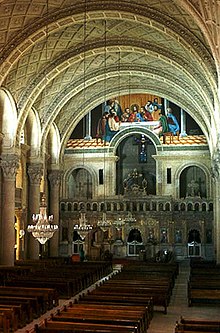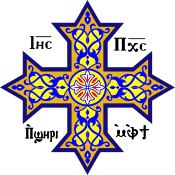Coptic history
This article includes a list of general references, but it lacks sufficient corresponding inline citations. (February 2024) |
| Part of a series on the |
| Copts |
|---|
| Culture |
|
| Regions |
| Denominations |
|
|
| Part of Oriental Orthodoxy |
 |
| Oriental Orthodox churches |
|---|
|
|
Coptic history is the part of the
Apostolic foundation
Egypt is identified in the Bible as the place of refuge that the Holy Family sought in its flight from Judea: "When he arose, he took the young Child and His mother by night and departed for Egypt, and was there until the death of Herod the Great, that it might be fulfilled which was spoken by the Lord through the prophet, saying, Out of Egypt I called My Son" (Matthew 2:12-23).
The Egyptian Church, which is now more than nineteen centuries old, regards itself as the subject of many prophecies in the Old Testament. Isaiah the prophet, in Chapter 19, Verse 19 says "In that day there will be an altar to the LORD in the midst of the land of Egypt, and a pillar to the LORD at its border."
The first
Catechetical School
Many scholars such as Jerome visited the school of Alexandria to exchange ideas and to communicate directly with its scholars. The scope of this school was not limited to theological subjects; science, mathematics and humanities were also taught there. The question-and-answer method of commentary began there, and 15 centuries before Braille, wood-carving techniques were in use there by blind scholars to read and write.
Cradle of Monasticism and its missionary work
Many Egyptian Christians went to the desert during the 3rd century, and remained there to pray and work and dedicate their lives to seclusion and worship of God. This was the beginning of the
Christian Monasticism was born in Egypt and was instrumental in the formation of the Coptic Orthodox Church character of submission, simplicity and humility, thanks to the teachings and writings of the Great Fathers of Egypt's Deserts. By the end of the 5th century, there were hundreds of monasteries, and thousands of cells and caves scattered throughout the Egyptian desert. A great number of these monasteries are still flourishing and have new vocations to this day.
All Christian monasticism stems, either directly or indirectly, from the Egyptian example:
Crafts
An
Edict of Milan
The
Council of Nicea
In the 4th century, an Alexandrian presbyter named Arius began a theological dispute about the nature of Christ that spread throughout the Christian world and is now known as Arianism (not to be confused with the Nazi ideology Aryanism). The Ecumenical Council of Nicea 325 AD was convened by the Roman Emperor Constantine I under the presidency of Hosius of Cordova and Pope Alexander I of Alexandria to resolve the dispute and eventually led to the formulation of the Symbol of Faith, also known as the Nicene Creed. The creed, which is now recited throughout most of the Christian world, was based largely on the teaching put forth by an Egyptian deacon Athanasius of Alexandria, patriarch of Alexandria and the chief opponent of Arius and his teachings.
Council of Constantinople
In the year 381 AD, Timothy I of Alexandria presided over the second ecumenical council known as the Ecumenical Council of Constantinople, which completed the Nicene Creed with this confirmation of the divinity of the Holy Spirit:
We believe in the Holy Spirit, the Lord, the Giver of Life, who proceeds from the Father, who with the Father and the Son is worshipped and glorified who spoke by the Prophets and in One, Holy, Catholic, and Apostolic Church. We confess one Baptism for the remission of sins and we look for the resurrection of the dead and the life of the coming age, Amen.[This quote needs a citation]
Council of Ephesus

Another theological dispute in the 5th century occurred over the teachings of
When reports of this reached the Apostolic Throne of
The First Ecumenical Council of Ephesus confirmed the teachings of
We magnify you O Mother of the True Light and we glorify you O saint and Mother of God (Theotokos) for you have borne unto us the Saviour of the world. Glory to you O our Master and King: Christ, the pride of the Apostles, the crown of the martyrs, the rejoicing of the righteous, firmness of the churches and the forgiveness of sins. We proclaim the Holy Trinity in One Godhead: we worship Him, we glorify Him, Lord have mercy, Lord have mercy, Lord bless us, Amen.[This quote needs a citation]
Council of Chalcedon

When in 451, Emperor
The Council of Chalcedon, from the perspective of the Alexandrine Christology, has deviated from the approved Cyrillian terminology and declared that Christ was one hypostasis in two natures. However, in the Nicene-Constantinopolitan Creed, "Christ was conceived of the Holy Spirit and of the Virgin Mary," thus the foundation of the definition according to the non-Chalcedonian adherents, according to the Christology of Cyril of Alexandria is valid.
In terms of Christology, the Oriental Orthodox (non-Chalcedonians) understanding is that Christ is "One Nature—the Logos Incarnate," of the full humanity and full divinity. The Chalcedonians understanding is that Christ is recognized in two natures, full humanity and full divinity.
The council's findings were rejected by many of the Christians on the fringes of the Byzantine Empire, including Egyptians, Syrians, Armenians, and others.
From that point onward, Alexandria would have two patriarchs: the non-Chalcedonian native Egyptian one, now known as the
Almost the entire Egyptian population rejected the terms of the Council of Chalcedon and remained faithful to the native Egyptian Church (now known as the Coptic Orthodox Church of Alexandria). Those who supported the Chalcedonian definition remained in
The
To make thing even worse, the Tome of Pope Leo of Rome was, according to the Alexandria school of theology, particularly in regards to the definition of Christology, considered influenced by Nestorian heretical teachings. So, due to the above-mentioned, especially in the consecutive sequences of events, the Hierarchs of Alexandria were considered holding too much of power from one hand, and on the other hand, due to the conflict of the schools of theology, an impasse was to be and there was a scape goat, i.e. Pope Disocoros.
By anathemizing Pope Leo, because of the tone and content of his Tome, as per Alexandrine theology perception, Pope Discoros was found guilty of doing so, without due process, in other words, the Tome of Leo was not a subject of heresy in the first place, but it was a question of questioning the reasons behind not having it either acknowledged or read at the Second Council of Ephesus in 449 AD. Pope Dioscorus of Alexandria was never labeled as heretic by the council's canons.
Copts also believe that the Pope of Alexandria was forcibly prevented from attending the third congregation of the council from which he was ousted, apparently the result of a conspiracy tailored by the Roman delegates.[8]
Before the current positive era of Eastern and Oriental Orthodox dialogues, Chalcedonians sometimes used to call the non-Chalcedonians "monophysites", though the Coptic Orthodox Church in reality regards monophysitism as a heresy. The Chalcedonian doctrine in turn came to be known as "dyophysite".
A term that comes closer to Coptic Orthodoxy is miaphysite, which refers to a conjoined nature for Christ, both human and divine, united indivisibly in the Incarnate Logos. The Coptic Orthodox Church of Alexandria believes that Christ is perfect in His divinity, and he is perfect in his humanity, but his divinity and his humanity were united in one nature called "the nature of the incarnate word", which was reiterated by Cyril of Alexandria.
Copts, thus, believe in two natures "human" and "divine" that are united in one hypostasis "without mingling, without confusion, and without alteration". These two natures "did not separate for a moment or the twinkling of an eye" (Coptic Liturgy of Saint Basil of Caesarea).
From Chalcedon to the Arab invasion of Egypt
Copts suffered under the rule of the
Arab-Muslim conquest of Egypt
The Arab Muslim conquest of Egypt took place in 639. Despite the political upheaval, historians estimate that the majority of the Egyptian population remained Christian until somewhere between the 9th century and the middle of the 14th century.[9]
There were major persecutions during and following the reign of the
During Islamic rule, the Copts were required to pay a special tax, called the jizya, in return for defense from the Caliphate as non-Muslims were not allowed to serve in the army. The payment of the jizya tax also meant that Copts were required to wear special clothing to distinguish them from Muslims and that they could practice their own Coptic Law exempt from Shari'a law courts.[11] This tax was abolished in 1855 under Sa'id Pasha.[11]
From the 19th century to the 1952 revolution
The position of the Copts began to improve early in the 19th century under the stability and tolerance of
Coptic historians
Over the centuries, many Coptic historians recorded the history of the Copts and that of the Coptic Church. The most prominent of these Coptic historians are:
- John of Nikiu(fl. 680-690), bishop and historian
- Severus Ibn al-Muqaffa (died 987), bishop, theologian, and historian; first compiler of the History of the Patriarchs of Alexandria
- Coptologist
- Menassa Youhanna (1899–1930), historian and theologian.
- Iris Habib Elmasry (1910–1994), author of The Story of the Copts (1978)[12]
- Labib Habachi (1906–1984), Egyptologist
See also
- Christian Egypt
- Coptic alphabet
- Coptic Saints
- Maria the Copt, a slave girl who became one of Muhammed's wives
References
- ^ Coptic history on Egypt state information Archived 2007-08-24 at the Wayback Machine
- ^ Coptic Church.net
- ^ Day, Lewis Foreman; Buckle, Mary (1901). Art in Needlework: A Book About Embroidery. B.T. Batsford.
- ^ calcademy Archived October 13, 2007, at the Wayback Machine
- ^ Johnson, David W. "Nestorius". Claremont Coptic Encyclopedia.
- ^ "Split of the Byzantine and Oriental Churches". Archived from the original on 2009-10-24. Retrieved 2009-10-26.
- ^ Greek Orthodox Patriarchate of Alexandria.
- ^ Romanides, John S. Leo of Rome's Support of Theodoret.
- doi:10.6082/M16Q1VB4.. O'Sullivan concludes in favor of an early date for Islamization during the 9th century, but cites Tamer el-Leithy as a recent defense of a later date during the 14th.
- ^ Kamil (1990).
- ^ a b Rowberry, Ryan; Khalil, John (2010). "A Brief History of Coptic Personal Status Law". Berkeley Journal of Middle Eastern and Islamic Law. 3: 81–139. Archived from the original on 2015-09-27. Retrieved 2019-11-26.
- ^ Miṣrī, Ī. Ḥ. (1978). The Story of the Copts. Egypt: Middle East Council of Churches.
Works cited
- Kamil, Jill (1990). Coptic Egypt: History and a Guide (2nd ed.). Cairo: American University in Cairo. ISBN 978-977-424-242-7.
Further reading
- Butcher, Edith L. (1897). The Story of the Church of Egypt: Being an Outline of the History of the Egyptians Under Their Successive Masters from the Roman Conquest Until Now. Smith, Elder, & Company. 2 vols.
- Meinardus, Otto F. A. (2010). Two Thousand Years of Coptic Christianity. The American University in Cairo Press. ISBN 978-9774247576.

